Geodesic polyhedron
This article may be too technical for most readers to understand. (January 2023) |
A geodesic polyhedron is a convex
Geodesic polyhedra are a good approximation to a sphere for many purposes, and appear in many different contexts. The most well-known may be the is an expansion of the concepts underlying geodesic polyhedra.
| ||||
| ||||
|
Geodesic notation
In Magnus Wenninger's Spherical models, polyhedra are given geodesic notation in the form {3,q+}b,c, where {3,q} is the Schläfli symbol for the regular polyhedron with triangular faces, and q-valence vertices. The + symbol indicates the valence of the vertices being increased. b,c represent a subdivision description, with 1,0 representing the base form. There are 3 symmetry classes of forms: {3,3+}1,0 for a tetrahedron, {3,4+}1,0 for an octahedron, and {3,5+}1,0 for an icosahedron.
The dual notation for
Values for b,c are divided into three classes:
- Class I (b=0 or c=0): {3,q+}b,0 or {3,q+}0,b represent a simple division with original edges being divided into b sub-edges.
- Class II (b=c): {3,q+}b,b are easier to see from the dual polyhedron {q,3} with q-gonal faces first divided into triangles with a central point, and then all edges are divided into b sub-edges.
- Class III: {3,q+}b,c have nonzero unequal values for b,c, and exist in chiral pairs. For b > c we can define it as a right-handed form, and c > b is a left-handed form.
Subdivisions in class III here do not line up simply with the original edges. The subgrids can be extracted by looking at a triangular tiling, positioning a large triangle on top of grid vertices and walking paths from one vertex b steps in one direction, and a turn, either clockwise or counterclockwise, and then another c steps to the next primary vertex.
For example, the icosahedron is {3,5+}1,0, and pentakis dodecahedron, {3,5+}1,1 is seen as a regular dodecahedron with pentagonal faces divided into 5 triangles.
The primary face of the subdivision is called a principal polyhedral triangle (PPT) or the breakdown structure. Calculating a single PPT allows the entire figure to be created.
The frequency of a geodesic polyhedron is defined by the sum of ν = b + c. A harmonic is a subfrequency and can be any whole divisor of ν. Class II always have a harmonic of 2, since ν = 2b.
The triangulation number is T = b2 + bc + c2. This number times the number of original faces expresses how many triangles the new polyhedron will have.

|
Elements
The number of elements are specified by the triangulation number . Two different geodesic polyhedra may have the same number of elements, for instance, {3,5+}5,3 and {3,5+}7,0 both have T=49.
| Symmetry | Icosahedral | Octahedral | Tetrahedral |
|---|---|---|---|
| Base | Icosahedron {3,5} = {3,5+}1,0 |
Octahedron {3,4} = {3,4+}1,0 |
Tetrahedron {3,3} = {3,3+}1,0 |
| Image | 
|

|

|
| Symbol | {3,5+}b,c | {3,4+}b,c | {3,3+}b,c |
| Vertices | |||
| Faces | |||
| Edges |
Construction
Geodesic polyhedra are constructed by subdividing faces of simpler polyhedra, and then projecting the new vertices onto the surface of a sphere. A geodesic polyhedron has straight edges and flat faces that approximate a sphere, but it can also be made as a
| Conway | u3I = (kt)I | (k)tI | ktI | |
|---|---|---|---|---|
| Image |  |
 |
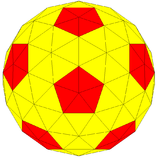 |
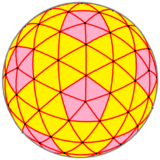
|
| Form | 3-frequency subdivided icosahedron |
Kis truncated icosahedron | Geodesic polyhedron (3,0) | Spherical polyhedron |
In this case, {3,5+}3,0, with frequency and triangulation number , each of the four versions of the polygon has 92 vertices (80 where six edges join, and 12 where five join), 270 edges and 180 faces.
Relation to Goldberg polyhedra
Geodesic polyhedra are the duals of
Examples
Class I
| Frequency | (1,0) | (2,0) | (3,0) | (4,0) | (5,0) | (6,0) | (7,0) | (8,0) | (m,0) |
|---|---|---|---|---|---|---|---|---|---|
| T | 1 | 4 | 9 | 16 | 25 | 36 | 49 | 64 | m2 |
| Face triangle |
 |
 |
 |
 |
 |
 |
 |
 |
... |
| Icosahedral | 
|

|

|

|

|
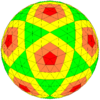
|
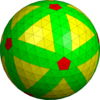
|
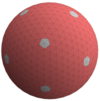
|
more |
| Octahedral | 
|
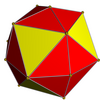
|

|
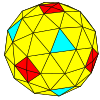
|

|
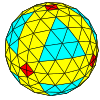
|

|
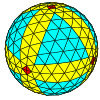
|
more |
| Tetrahedral | 
|
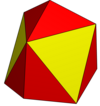
|

|

|

|
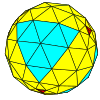
|
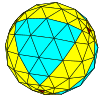
|

|
more |
Class II
| Frequency | (1,1) | (2,2) | (3,3) | (4,4) | (5,5) | (6,6) | (7,7) | (8,8) | (m,m) |
|---|---|---|---|---|---|---|---|---|---|
| T | 3 | 12 | 27 | 48 | 75 | 108 | 147 | 192 | 3m2 |
| Face triangle |
 |
 |
 |
 |
 |
 |
 |
 |
... |
| Icosahedral | 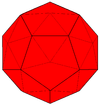
|

|

|
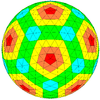
|
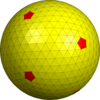
|

|

|
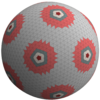
|
more |
| Octahedral | 
|

|
more | ||||||
| Tetrahedral | 
|
more |
Class III
| Frequency | (2,1) | (3,1) | (3,2) | (4,1) | (4,2) | (4,3) | (5,1) | (5,2) | (m,n) |
|---|---|---|---|---|---|---|---|---|---|
| T | 7 | 13 | 19 | 21 | 28 | 37 | 31 | 39 | m2+mn+n2 |
| Face triangle |
 |
 |
 |
 |
 |
 |
 |
 |
... |
| Icosahedral | 
|

|

|

|
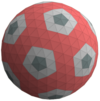
|
more | |||
| Octahedral | 
|
more | |||||||
| Tetrahedral | 
|
more |
Spherical models
Magnus Wenninger's book Spherical Models explores these subdivisions in building polyhedron models. After explaining the construction of these models, he explained his usage of triangular grids to mark out patterns, with triangles colored or excluded in the models.[6]
geodesic sphere , {3,5+}16,0
|
 A virtual copy showing icosahedral symmetry great circles. The 6-fold rotational symmetry is illusionary, not existing on the icosahedron itself. |
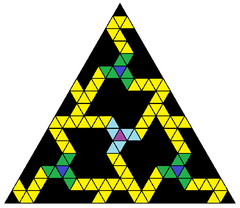 A single icosahedral triangle with a 16-frequency subdivision |
See also
References
This article includes a list of general references, but it lacks sufficient corresponding inline citations. (March 2023) |
- PMID 14019094.
- ^ Coxeter, H.S.M. (1971). "Virus macromolecules and geodesic domes.". In Butcher, J. C. (ed.). A spectrum of mathematics. Oxford University Press. pp. 98–107.
- pollen grain.
- ^ "Mesh Primitives", Blender Reference Manual, Version 2.77, retrieved 2016-06-11.
- ^ "What is the difference between a UV Sphere and an Icosphere?". Blender Stack Exchange.
- ^ Wenninger (1979), pp. 150–159.
Bibliography
- Williams, Robert (1979). The Geometrical Foundation of Natural Structure: A source book of Design. pp. 142–144, Figure 4-49, 50, 51 Custers of 12 spheres, 42 spheres, 92 spheres.
- Pugh, Antony (1976). "Chapter 6. The Geodesic Polyhedra of R. Buckminster Fuller and Related Polyhedra". Polyhedra: a visual approach.
- ISBN 978-0-486-40921-4.
- Popko, Edward S. (2012). "Chapter 8. Subdivision schemas, 8.1 Geodesic Notation, 8.2 Triangulation number 8.3 Frequency and Harmonics 8.4 Grid Symmetry 8.5 Class I: Alternates and fords 8.5.1 Defining the Principal triangle 8.5.2 Edge Reference Points". Divided spheres: Geodesics & the Orderly Subdivision of the Sphere.

















